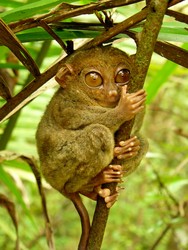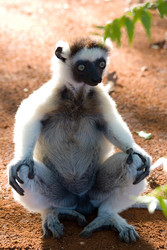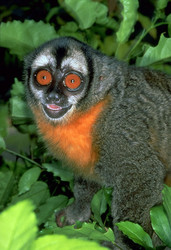Primates
Lemurs, tarsiers, monkeys, apes, and humans



This tree diagram shows the relationships between several groups of organisms.
The root of the current tree connects the organisms featured in this tree to their containing group and the rest of the Tree of Life. The basal branching point in the tree represents the ancestor of the other groups in the tree. This ancestor diversified over time into several descendent subgroups, which are represented as internal nodes and terminal taxa to the right.

You can click on the root to travel down the Tree of Life all the way to the root of all Life, and you can click on the names of descendent subgroups to travel up the Tree of Life all the way to individual species.
For more information on ToL tree formatting, please see Interpreting the Tree or Classification. To learn more about phylogenetic trees, please visit our Phylogenetic Biology pages.
close boxReferences
Adkins, R. M. and R. L. Honeycutt. 1994. Evolution of the primate cytochrome c oxidase subunit II gene. Journal of Molecular Evolution 38:215-231.
Arnason, U., A. Gullberg, and A. Janke. 1998. Molecular timing of primate divergences as estimated by two nonprimate calibration points. Journal of Molecular Evolution 47:718-727.
Bailey, W. J., D. H. A. Fitch, D. A. Tagle, J. Czelusniak, J. L. Slightom, and M. Goodman. 1991. Molecular evolution of the PSI-eta-globin gene locus: Gibbon phylogeny and the hominoid slowdown. Molecular Biology and Evolution 8:155-184.
Barton, R. A. 2004. Binocularity and brain evolution in primates. Proceedings of the National Academy of Sciences (USA) 101(27):10113-10115.
Bloch, J. I. and D. M. Boyer. 2002. Grasping primate origins. Science298:1606-1610.
Bloch, J. I., D. C. Fisher, P. D. Gingerich, G. F. Gunnell, E. L. Simons, and M. D. Uhen. 1997. Cladistic analysis and anthropoid origins. Science 278:2134-2135.
Fleagle, J. G. 1999. Primate Adaptation and Evolution. Academic Press, San Diego.
Flynn, J. J., A. R. Wyss, R. Charrier, and C. C. Swisher. 1995. An Early Miocene anthropoid skull from the Chilean Andes. Nature 373:603-607.
Gebo, D. L., M. Dagosto, K. C. Beard, and T. Qi. 2000. The smallest primates. Journal of Human Evolution 38:585-594.
Gebo, D. L., M. Dagosto, K. C. Beard, T. Qi, and J. W. Wang. 2000. The oldest known anthropoid postcranial fossils and the early evolution of higher primates. Nature 404:276-278.
Glazko, G. V. and M. Nei. 2003. Estimation of divergence times for major lineages of primate species. Molecular Biology and Evolution 20(3):424-434.
Goodman, M., W. J. Bailey, K. Hayasaka, M. J. Stanhope, J. Slightom, and J. Czelusniak. 1994. Molecular evidence on primate phylogeny from DNA sequences. American Journal of Physical Anthropology 94:3-24.
Goodman, M., C. A. Porter, J. Czelusniak, S. L. Page, H. Schneider, J. Shoshani, G. Gunnell, and C. P. Groves. 1998. Toward a phylogenetic classification of primates based on DNA evidence complemented by fossil evidence. Molecular Phylogenetics and Evolution 9:585-598.
Hartwig, W. C., ed. 2002. The Primate Fossil Record. Cambridge Studies in Biological and Evolutionary Anthropology 33. Cambridge University Press, Cambridge, New York.
Jaworski, C. J. 1995. A reassessment of mammalian alpha-A-crystallin sequences using DNA sequencing: Implications for anthropoid affinities of tarsier. Journal of Molecular Evolution 41:901-908.
Johnson, W.E. and J. M. Coffin. 1999. Constructing primate phylogenies from ancient retrovirus sequences. Proceedings of the National Academy of Sciences (USA) 96:10254-10260.
Kappeler, P. M. 1998. Nests, tree holes, and the evolution of primate life histories. American Journal of Primatology 46:7-33.
Kay, R. F., C. Ross, and B. A. Williams. Anthropoid origins. Science 275:797-804.
Kay, R. F., C. Ross, B. A. Williams, and D. Johnson. 1997. Cladistic analysis and anthropoid origins - Response. Science 278:2135-2136.
Koop, B. F., D. A. Tagle, M. Goodman, and J. L. Slightom. 1989. A molecular view of primate phylogeny and important systematic and evolutionary questions. Molecular Biology and Evolution 6:580-613.
Lockwood, C. A. and J. G. Fleagle. 1999. The recognition and evaluation of homoplasy in primate and human evolution. Yearbook of Physical Anthropology 42:189-232.
Martin, R. D. 1993. Primate origins: plugging the gaps. Nature 262:223-234.
Miyamoto, M. M. and M. Goodman. 1990. DNA systematics and evolution of primates. Annual Review of Ecology and Systematics 21:197-220.
Porter, C. A., S. L. Page, J. Czelusniak, H. Schneider, M. P. C. Schneider, I. Sampaio, and M. Goodman. 1997. Phylogeny and evolution of selected primates as determined by sequences of the epsilon-globin locus and 5' flanking regions. International Journal of Primatology 18:261-295.
Porter, C. A., I. Sampaio, H. Schneider, M. P. C. Schneider, J. Czelusniak, and M. Goodman. 1995. Evidence on primate phylogeny from epsilon-globin gene-sequences and flanking regions. Journal of Molecular Evolution 40:30-55.
Purvis, A. 1995. A composite estimate of primate phylogeny. Philosophical Transactions of the Royal Society of London Series B 348:405-421.
Purvis, A., S. Nee, and P. H. Harvey. 1995. Macroevolutionary inferences from primate phylogeny. Proceedings of the Royal Society London Series B 260:329-333.
Rasmussen, D. T., G. C. Conroy, and E. L. Simons. 1998. Tarsier-like locomotor specializations in the Oligocene primate Afrotarsius. Proceedings of the National Academy of Sciences (USA) 95:14848-14850.
Robson, S. K., G. W. Rouse, and J. D. Pettigrew. 1997. Sperm ultrastructure of Tarsius bancanus (Tarsiidae, Primates): Implications for primate phylogeny and the use of sperm in systematics. Acta Zoologica Stockholm 78:269-278.
Ross, C. 1996. Adaptive explanation for the origins of the Anthropoidea (primates). American Journal of Primatology 40:205-230.
Ross, C., B. Williams, and R. F. Kay. 1998. Phylogenetic analysis of anthropoid relationships. Journal of Human Evolution 35:221-306.
Schmitz, J., M. Ohme, and H. Zischler. 2001. SINE insertions in cladistic analyses and the phylogenetic affiliations of Tarsius bancanus to other primates. Genetics 157(2):777-784.
Schrago, C. G. and C. A. M. Russo. 2003. Timing the origin of New World monkeys. Molecular Biology and Evolution 20(10):1620-1625.
Shoshani, J., C. P. Groves, E. L. Simons, and G. F. Gunnell. 1996. Primate phylogeny: Morphological vs molecular results. Molecular Phylogenetics and Evolution 5:102-154.
Simons, E. 1995. Egyptian Oligocene primates: A review. Yearbook of Physical Anthropology 38:199-238.
Tavaré, S., C. R. Marshall, O. Will, C. Soligo, and R. D. Martin. 2002. Using the fossil record to estimate the age of the last common ancestor of extant primates. Nature 416:726-729.
Information on the Internet
- The Wisconsin Regional Primate Research Center (WRPRC). Provides acces to a variety of resources including:
- BIOSIS BiologyBrowser: Primates
- California Regional Primate Research Center. University of California, Davis.
- American Society of Primatologists
- Primate Cytogenetics Network
- The Virtual Skeletons Project. University of Texas at Austin.
- Order Primates. The University of Michigan Museum of Zoology Animal Diversity Web.
- Introduction to Primates. Mesa Community College Exploratorium of Our Kind.
- Primate Display. University of Edinburgh's Natural History Museum.
- Information on recent finds of fossil primates in China:
- Searching for Our Primate Ancestors in China. An article by Carnegie paleontologist Chris Beard.
- Newly discovered fossils from China shed light on the common ancestry of monkeys, apes and humans . Northern Illinois University News Release.
- Researchers discover fossils of tiny, thumb-length primates. Northern Illinois University News Release.
- Primates Online. Primate Conservation & Welfare Society.
- Electronic Zoo Primates Page. Links to primate information on the web.
- Tim Knight's Primate Gallery. Primate photos, illustrations, and paintings by various artists.
- Steve Bloom's Primates Project. A collection of great primate photos.
Title Illustrations

| Scientific Name | Tarsius syrichta |
|---|---|
| Location | Tarsier Sanctuary, Corella, Bohol, Philippines |
| Specimen Condition | Live Specimen |
| Source | Tarsier Sanctuary, Corella, Bohol |
| Source Collection | Flickr |
| Image Use |
 This media file is licensed under the Creative Commons Attribution License - Version 2.0. This media file is licensed under the Creative Commons Attribution License - Version 2.0.
|
| Copyright | © 2007 Kok Leng Yeo |
| Scientific Name | Chlorocebus pygerythrus |
|---|---|
| Location | Lake Nakuru, Kenya |
| Specimen Condition | Live Specimen |
| Source | Breast is best |
| Source Collection | Flickr |
| Image Use |
 This media file is licensed under the Creative Commons Attribution-NonCommercial-NoDerivs License - Version 2.0. This media file is licensed under the Creative Commons Attribution-NonCommercial-NoDerivs License - Version 2.0.
|
| Copyright | © 2008 Lip Kee Yap |
| Scientific Name | Propithecus verreauxi |
|---|---|
| Location | Berenty Reserve, Madagascar |
| Specimen Condition | Live Specimen |
| Source | _MG_6928 |
| Source Collection | Flickr |
| Image Use |
 This media file is licensed under the Creative Commons Attribution-NonCommercial-ShareAlike License - Version 2.0. This media file is licensed under the Creative Commons Attribution-NonCommercial-ShareAlike License - Version 2.0.
|
| Copyright | © 2007 Steve Johnson |
| Scientific Name | Aotus trivirgatus |
|---|---|
| Location | captive individual photographed in small tree in Iquitos, Peru |
| Specimen Condition | Live Specimen |
| Copyright |
© 1997 Greg and Marybeth Dimijian

|
About This Page
Page copyright © 1999
All Rights Reserved.
Citing this page:
Tree of Life Web Project. 1999. Primates. Lemurs, tarsiers, monkeys, apes, and humans. Version 01 January 1999 (temporary). http://tolweb.org/Primates/15963/1999.01.01 in The Tree of Life Web Project, http://tolweb.org/













 Go to quick links
Go to quick search
Go to navigation for this section of the ToL site
Go to detailed links for the ToL site
Go to quick links
Go to quick search
Go to navigation for this section of the ToL site
Go to detailed links for the ToL site